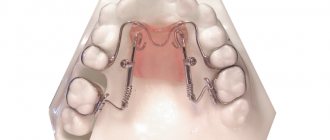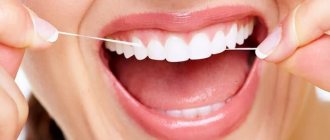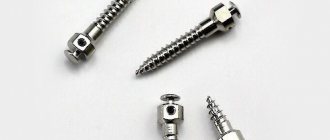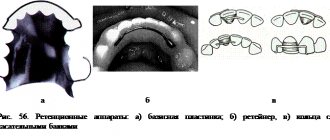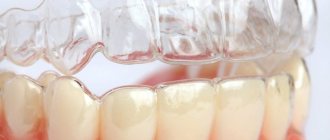An orthodontic plate is a special device necessary to correct the bite and teeth. The design includes the plate itself, a metal arc and fasteners. Metal parts are made of titanium and nickel alloy. The vestibular plate is made individually for each patient, based on the anatomical features of the jaw, the degree of curvature of the dentition and the desired result. The plate is made on the basis of previously taken impressions of the patient’s jaw.
Orthodontists at the 32 Dent clinic specialize in installing individual plates for the correction of pathologies in children and adults. Here we provide an integrated approach, clear control of the doctor, proper motivation, and a guarantee of results.
How does a vestibular plate work?
Each plate has a “memory”, thanks to which the metal arcs still return to their original positions. This is important in the process of correcting the bite, when the arch “moves” the patient’s jaw bones and teeth to the required correct parameters. The orthodontist’s task is to select a plate with metal elements of such thickness and tension force that it works effectively in each specific case.
The plate may also have a special “clasp” that corrects its position during the treatment period. The lock is tightened at certain intervals, thereby correcting the bite.
When is the record used?
- for the treatment of abnormal position of teeth (canines and incisors);
- to correct a situation where a patient has had a tooth removed that had erupted out of place;
- to obtain a healthy bite without removing healthy teeth.
Why do patients choose vestibular plates? Advantages and disadvantages of designs
Pros of orthodontic plates:
- The price is within reason.
Low cost compared to the same braces (the cost of the design ranges from 8,000 to 10,500 rubles per course of treatment);
- Easy to wear and hygienic.
The patient can easily remove it from the mouth before eating, wash it, and put on the device independently.
- Eat what you like.
When wearing plates, there are no restrictions on food consumption. You can eat meat, hard and sticky foods. The design is simply removed before eating and put on afterwards. - Correction of the position by a doctor or independently.
During dental treatment, you can always adjust the tension force. This can be done by the patient himself, tightening the lock, or by the dentist during a follow-up visit.
- Optimal aesthetics.
People around see only a metal arc on the teeth, and with close contact, the interlocutor practically does not notice the plate.
The nuances of using orthodontic plates for teeth:
- Wear for about 2 years.
The estimated duration of treatment is 20 months or more, depending on the pathology of the bite. In any case, the treatment is worth it so that after about two years the teeth are straight and healthy.
- Some discomfort for the patient.
It is felt immediately after installing the device on the teeth or after tightening it, but patients quickly get used to this position.
- It is impossible to correct serious pathologies.
Unfortunately, vestibular plates are not able to correct serious pathologies of the bite and teeth. In this case, orthodontists recommend treatment with braces.
- It all depends on the patient's motivation.
This is especially true for children who do not always strictly follow doctors’ recommendations for regularly wearing plates. In addition, the plate must be worn on the teeth for 20–22 hours, and not every child agrees to follow this iron rule.
How plates are installed on teeth
Before starting to manufacture and install an orthopedic plate for teeth, the dentist carefully examines the patient’s oral cavity and determines any existing pathologies. Then X-ray diagnostics are carried out and impressions are taken from the jaws. After successful fitting (the casts must perfectly match the shape of the jaws), a plate is made based on the plaster model.
Installing a plate to straighten teeth is not particularly difficult and does not require much time. The whole procedure will take no more than 10 minutes.
But the first installation must be carried out under the supervision of a dentist. It may be accompanied by increased salivation and speech defects. But soon the problems will disappear, and the teeth straightening plate will not cause any discomfort.
From time to time it is necessary to contact the dentist and tighten the screws on the plate to straighten the teeth, which will increase the load and correct the defect.
Removable plates
Removable plates for teeth are made of high-tech plastic that does not have a harmful effect on the body. They can be installed on the lower jaw, on the upper jaw, or on both together.
This plate is secured to straighten teeth using special hooks. If necessary, springs and screws are installed, which increases the cost.
The advantages of such plates include:
- 100% no allergies;
- the ability to remove it while eating and for cleaning;
But they also have disadvantages: fragility and staining with food coloring. In addition, removable orthodontic structures are unable to correct serious pathologies.
Therefore, removable plates for straightening teeth are in most cases installed on children and adolescents, since their dental apparatus is not fully formed and is much easier to handle. The action of the plates will be especially effective at the age of 7-12 years.
Fixed plates
A non-removable plate on the teeth is installed on the outside of the dentition. It is made of metal arcs (nickel or titanium), which are passed through special locks. The arches are gradually tightened, which ensures bite alignment on both the upper and lower jaws.
Typically, similar dental plates are installed for adults. They allow you not only to remove gaps between teeth, but also to correct serious bite deformities.
How long should you wear the record?
Removable plates are worn for 1.5-2 years, but they need to be replaced every 6-12 months.
Fixed plates for straightening teeth have been used for several years. The duration of wearing is determined by the dentist, based on the severity of the pathology.
Benefits of using dental plaques
Plates for straightening teeth compared to other orthodontic structures are characterized by the following advantages:
- quickly manufactured;
- hypoallergenic: made from environmentally friendly material;
- accelerate the growth of jaw bones, the development of which was slow;
- keep teeth in the required position;
- change the size of the sky;
- eliminate gaps between teeth;
- do not cause discomfort;
- do not require special care;
- have a relatively low cost (2-3 times cheaper than braces);
- prevent surgery.
Teeth straightening plates are custom-made to ensure an optimal fit to the patient's jaw. They precisely match the relief of the gums and the contour of the teeth.
We make records in any color and design the child wishes.
Types of orthodontic plates
Depending on the type of construction, individual vestibular plates can be removable or non-removable. We will not consider fixed structures, since they are used extremely rarely in orthodontic practice.
7 types of removable orthodontic vestibular plates:
1. Frenkel system – a removable plate with protective elements for lips and cheeks;
2. For one jaw – a vestibular plate, which is used to correct the position of single teeth;
3. Bruckle system - a plate designed to correct a strongly protruded chin;
4. A plate equipped with a retraction arc - a device that is necessary to correct the position of the incisor teeth;
5. The Andresen-Goipl system, affecting the lower and upper jaws;
6. A removable plate with a push element is designed to expand the patient's upper jaw;
7. A plate with a process, necessary for the correction of one tooth (most often incisors).
What are records for?
The functions of orthodontic plates can be different. This depends on the design of the device and the presence of certain active elements. Most often, plates are used for the following purposes:
- Expansion of dentition . To do this, use plates with a screw. Using a special key, the width of the plate is adjusted. The device is often used for mesial occlusion and crowded teeth. It allows you to achieve expansion of the frontal part of the upper jaw.
- Distalization of molars . Such devices allow you to “move” the molars back, freeing up space for the normal arrangement of the frontal teeth. Such equipment is indicated for severe crowding of teeth, deep and mesial occlusion.
- Retention – stabilization of the position of teeth . A classic orthodontic plate with clasps allows you to avoid relapse after braces. It fixes the teeth in a new position, preventing them from moving to their original position.
The use of various active elements (springs, screws, artificial teeth, flaps or tongue training elements) can significantly expand the functions of the plate and achieve excellent treatment results.
Plates for correcting “milk bite” for the youngest children
The bite can also be corrected for young children. There are a number of orthodontic plates for this purpose:
plate with a wire shutter - used to correct an open bite, when when the jaws are closed, there is a gap between them;
a plate with a special “bead” - a design that is used in case of incorrect position of the tongue, and, consequently, pronounced speech defects;
classic plastic plate - recommended for frequent mouth breathing (breathing correctly - through the nose), the habit of thumb sucking;
vestibular with a special element in the form of a visor - with underdevelopment of the lower jaw due to thumb or pacifier sucking.
The need to correct the bite of children with primary teeth is determined by a pediatric orthodontist. As a rule, this is necessary for genetic predisposition, jaw injuries, obvious orthodontic deviations, which are easier and faster to correct at this age. Plates for small children are equipped with special plastic holder rings to prevent accidental passage of the plate.
How should you wear the record? Basic rules and expert recommendations
The approximate period of correction using a plate ranges from several months to two and a half years.
Most of the time, the vestibular plate is in the mouth: always at night, as well as during the day with breaks for meals. The approximate total time the tablet remains in the mouth is 20-23 hours.
While the patient is eating or performing dental hygiene procedures, the plate is placed in a special container with liquid. It is always washed after removal from the mouth and before insertion.
The record should be thoroughly cleaned daily as part of standard hygiene rituals to prevent plaque from forming on the metal and plastic parts.
Orthodontic onlays for teeth
With the help of occlusal overlays, dentists are able to restore the height of the bite, create ideal conditions for the functioning of the joint and prevent its destruction. Also, with the help of such microprostheses, facial proportionality is restored* and chewing is improved.
*Due to a decrease in the bite, the lower third of the face is shortened, so the nasolabial folds become deep, the corners of the mouth droop, macerate (wet, ulcerate).
To correct occlusion, restoration of teeth is often required, because when the crowns are partially destroyed or abraded, the way the jaws close and their mutual movements completely change. For this purpose, occlusal onlays for teeth of the on-lay type have been used in orthodontics.
Such designs allow you to restore the cusps and fissures on the teeth to ensure their ideal occlusion and articulation. They are supporting and retaining elements capable of transmitting functional forces to the lateral teeth. Microprostheses are not used on incisors and canines.
Types of overlays
According to their location, the linings can be single-sided or double-sided. Their number and placement are dictated by the characteristics of the clinical situation - the decision is made by an orthodontist or orthopedist.
Features of orthopedic occlusal pads and their purpose
Onlay can also be compared to a filling, a restoration that is not made directly in the mouth, but in a laboratory. The design has the following characteristics:
- Preparation method. The onlay is created by dental technicians in the laboratory, focusing on the individual impression of the patient’s jaw. First, a wax reproduction is made, which is then packaged and replaced with permanent material. The finished structures are fixed to the teeth and cannot be removed.
- Physiology. An onlay differs from a filling in being more durable and able to recreate the anatomy of the teeth as accurately as possible.
- Minimally invasive manipulation. When creating structures, doctors try to preserve the natural tissues of the teeth.
The tasks that occlusal pads solve include:
- Reducing the depth of immersion of the prosthesis towards the mucous membrane if the patient wears it. This prevents compression of the gums.
- Unloading of the supporting teeth - they experience less pressure in the lateral directions.
- Distribution of chewing load from the base of the prosthesis to the teeth that limit the defect.
- Stabilization of the position of the prosthesis on the jaw.
- Preventing food from getting under the denture.
- Raising the bite height for optimal joint function.
- Bite separation, if necessary (for periodontal diseases or to facilitate tooth movement, for example).
Doctors carefully examine patients, study the clinical picture and outline therapy goals, drawing up a treatment plan. Each individual case has its own set of initial data from which to build. It is not always possible to fix a problem using only one method. Most often, a complex of different measures is needed—a multifaceted approach.
Front overlays
In orthodontics, anterior onlays are also used for use in the anterior dentition. They are single or multi-link.
Singles are divided into:
- oral, located on the distal side of the tooth;
- medial - indicated if the supporting fangs have become loose;
- shoulder pads - for stabilizing the orthopedic structure and splinting mobile teeth;
- double-arm stop – fixed to the distal surface of the canine crowns, replaces clasps when defects are included.
Multi-link type onlays are used on the lower jaw and are narrow, medium and wide. They do not fix the structure, but improve its stability.
The narrow ones are fixed above the dental cusps, and the medium ones cover the crown of the tooth right up to the cervical area. Expanded ones are the most voluminous of all onlays and are indicated for certain anatomical features of the patient’s palate.
Materials
Orthodontic onlays are made from composite or ceramic. The first ones are cheaper and easier to manufacture. They are preferred in cases where these elements are needed as a temporary measure, and later they are replaced by permanent ones - ceramic linings.
Thanks to occlusal fillings, bite correction with a brace system is reduced by 2 times on average.
There are also completely different products - silicone pads. These are elements that are superimposed on a specific part of the dentition. Most often they are used to restore the functioning of the TMJ.
Orthopedic onlays are made of metal - these are shaped clasps that do not interfere with natural occlusion, but help to better distribute the chewing load between the supporting teeth and the prosthesis.
How to motivate children to wear an orthodontic plate?
- Demonstrate the result in 3D format so that a person sees his teeth after treatment and understands the importance of such changes;
- Convey all the benefits of wearing a plate: a beautiful face, clear speech, self-confidence, the ability to walk more often and attend clubs without missing out due to colds, straight and flawless teeth, proper development;
- It is important to approach treatment in a playful way, to perform myogymnastics in a fun format. The orthodontist will tell you about this when drawing up a treatment plan.
